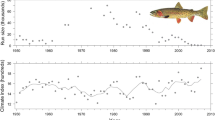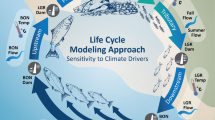Abstract
Regional climates are a major factor in determining the distribution of many species. Anthropogenic inputs of greenhouse gases into the atmosphere have been predicted to cause rapid climatic changes in the next 50–100 years. Species such as the Gila trout (Oncorhynchus gilae) that have small ranges, limited dispersal capabilities, and narrow physiological tolerances will become increasingly susceptible to extinction as their climate envelope changes. This study uses a regional climate change simulation (Leung et al., Clim Change 62:75–113, 2004) to determine changes in the climate envelope for Gila trout, which is sensitive to maximum temperature, associated with a plausible scenario for greenhouse gas increases. These regional climate changes are downscaled to derive surface temperature lapse rates using regression models. This procedure indicates that suitable, warm season habitat for Gila trout will be reduced by 70% by decreasing the size of their climate envelope. Warmer temperatures coupled with a decrease in summer precipitation would also tend to increase the intensity and frequency of forest fires that are a major threat to their survival. The climate envelope approach utilized here could be used to assess climate change threats to other rare species with limited ranges and dispersal capabilities.
Similar content being viewed by others
References
Bakkenes M, Alkemade JRM, Ihle F, Leemans R, Latour JB (2002) Assessing effects of forecasted climate change in the diversity and distribution of higher plants for 2050. Glob Chang Biol 8(4):390–407
Behnke A (1992) Native Trout of Western North America (AFS monograph number 6). American Fisheries Society
Brown DK, Echelle AE, Probst DL, Brooks JE, Fisher WL (2001) Catastrophic wildfire and number of populations as factors influencing risk of extinction for Gila Trout (Oncorhynchus gilae). West N Am Nat 61(2):139–148
Carpenter SR, Fisher SG, Grimm NB, Kitchell JF (1992) Global change and freshwater ecosystems. Ann Rev Ecol Syst 23:119–139
Christensen JH, Hewitson B, Busuioc A, Chen A, Gao X, Held I, Jones R, Kolli RK, Kwon W-T, Laprise R, Magaña Rueda V, Mearns L, Menéndez CG, Räisänen J, Rinke A, Sarr A, Whetton P (2007) Regional climate projections. Climate Change 2007: the physical science basis. In: Solomon S, Qin D, Manning M, Chen Z, Marquis M, Averyt KB, Tignor M, Miller HL (eds) Contribution of working group I to the fourth assessment report of the intergovernmental panel on climate change. Cambridge University Press, Cambridge
Cooney SJ, Covich AP, Lukacs PM, Harig AL, Fausch KD (2005) Modeling global warming scenarios in greenback cutthroat trout (Oncorhynchus clarki stomias) streams: implications for species recovery. West N Am Nat 65(3):371–381
Dai A, Washington WM, Meehl GA, Bettge TW, Strand WG (2004) The ACPI climate change simulations. Clim Change 62:29–43
Davis AJ, Jenkinson LS, Lawton JH, Shorrocks B, Wood S (1998) Making mistakes when predicting shifts in species range. Nature 391:783–786
Dickerson BR, Vinyard GL (1999) Effects of high chronic temperatures and diel temperature cycles on the survival and growth of Lahontan cutthroat trout. Trans Am Fish Soc 128(3):516–521
Dunham J, Schroeter R, Rieman B (2003) Influence of maximum water temperature on occurrence of Lahontan cutthroat trout within streams. North Am J Fish Manage 23(3):1042–1049
Erasmus BFN, Van Jaarsveld AS, Chown SL, Kshatriya M, Wessels KJ (2002) Vulnerability of South African animal taxa to climate change. Glob Chang Biol 8:679–693
Goosef MN, Strzepek K, Chapra SC (2005) Modeling potential effects of climate change on water temperature downstream of a shallow reservoir, lower Madison River, MT. Clim Change 68(3):331–353
Hanski IA, Gilpin ME (1997) Metapopulation biology: ecology, genetics, and evolution. Academic Press, San Diego
Hill JK, Thomas CD, Huntley B (1999) Climate change and habitat availability determine 20th century changes in a butterfly’s range margin. Proc R Acad Sci B 266:1197–1206
Hogg ID, Williams DD (1996) Response of stream invertebrates to a global-warming thermal regime: an ecosystem-level manipulation. Ecology 77(2):395–407
Hurd BH, Coonrod J (2007) Climate change and its implications for New Mexico’s water resources and economic opportunities. New Mexico State University, p 44
Intergovernmental Panel on Climate Change (2007) Climate change 2007: the physical science basis. Cambridge University Press, Cambridge
Jager HI, Van Winkle W, Holcomb BD (1999) Would hydrologic climate changes in Sierra Nevada streams influence trout persistence? Trans Am Fish Soc 128(2):222–240
Johnstone HC, Rahel FJ (2003) Assessing temperature tolerance of Bonneville cutthroat trout based on constant and cycling thermal regimes. Trans Am Fish Soc 132(1):92–99
Keleher CJ, Rahel FJ (1996) Thermal limits to Salmonid distributions in the Rocky Mountain region and potential habitat loss due to global warming: a geographic information system (GIS) approach. Trans Am Fish Soc 125(1):1–13
Khandekar ML, Murty TS, Chittibabu P (2005) Global warming debate: a review of the state of science. Pure Appl Geophys 162:1557–1586
Lande R (1993) Risks of population extinction from demographic and environmental stochasticity and random catastrophes. Am Nat 142(6):911–927
Lawton JL (2000) Concluding remarks: a review of some open questions. In: Hutchings MJ, John E, Stewart AJA (eds) Ecological consequences and heterogeneity. Cambridge University Press, Cambridge, pp 401–424
Leung LR, Wigmosta MS, Ghan SJ, Epstein DJ, Vail LW (1996) Application of a subgrid orographic precipitation/surface hydrology scheme to a mountain watershed. J Geophys Res 101(D8):12803–12818
Leung LR, Qian Y, Bian X, Washington WM, Han J, Roads JO (2004) Mid-century ensemble regional climatic change scenarios for the western United States. Clim Change 62:75–113
Leung LR, Wigmosta MS (1999) Potential climate change impacts on mountain watersheds in the Pacific northwest. J Am Water Resour Assoc 35(6):1463–1471
Levins R (1969) Some demographic and genetic consequences of environmental heterogeneity for biological control. Bulletin Entomological Society of America 15:237–240
Meeuwig MH, Dunham JB, Hayes JP, Vinyard GL (2004) Effects of constant and cyclical thermal regimes on growth and feeding of juvenile cutthroat trout of variable sizes. Ecol Freshw Fish 13:208–216
Meisner JD (1990) Effect of climate warming on the southern margins of the native range of brook trout, Salvelinus fontinalis. Can J Fish Aquat Sci 47:1065–1070
Mohseni O, Stefan HG, Eaton JG (2003) Global warming and potential changes in fish habitat in U.S. streams. Clim Change 59:389–409
Morrill JC, Bales RC, Conklin MH (2005) Estimating stream temperature from air temperature: implications for future water quality. J Environ Eng 131:139–145
National Assessment Synthesis Team (2001) Climate change impacts on the United States. Cambridge University Press, Cambridge
Peterson AT, Ortega-Huerta MA, Bartley J, Sanchez-Cordero V, Soberon J, Buddemeier RH, Stockwell DRB (2002) Future predictions for Mexican faunas under global climate change scenarios. Nature 416:626–629
Preston BL (2006) Risk-based reanalysis of the effects of climate change on US cold-water habitat. Clim Change 76(1–2):91–119
Propst DL, Stefferud JA, Turner PR (1992) Conservation and status of Gila trout, Oncorhynchus gilae. The Southwest Nat 37(2):117–125
Propst DL, Stefferud JA (1997) Population dynamics of Gila trout in the Gila River drainage of the south-western United States. J Fish Biol 51:1137–1154
Rees PM (2002) Land–plant diversity and the end-Permian mass extinction. Geology 30(9):827–830
Rahel FJ, Nibbenlink NP (1999) Spatial patterns in relations among brown trout (Salmo trutta) distribution, summer air temperature, and stream size in Rocky Mountain streams. Can J Fish Aquat Sci 56(1):43–51
Schmitz OJ, Post E, Burns CE, Johnston KM (2003) Ecosystem response to global climate change. Bioscience 53(12):1199–1205
Scott D, Poynter M (1991) Upper limits for trout in New Zealand and climate change. Hydrobiology 222:147–151
Shackley S, Young P, Parkinson S, Wynne B (1998) Uncertainty, complexity and concepts of good science in climate change modeling: are GCMs the best tools? Clim Change 38(2):159–205
Shuter BJ, Post JR (1990) Climate, population viability, and the zoogeography of temperate fishes. Trans Am Fish Soc 119:314–336
Sloat MR, Shepard BB, White RG, Carson S (2005) Influence of stream temperature on the spatial distribution of westslope cutthroat trout growth potential within the Madison River Basin, Montana. North Am J Fish Manage 25(1):225–237
U.S. Fish and Wildlife Service (2003) Gila trout recovery plan (third revision). Albuquerque, New Mexico. i–vii + 78 pp
Wagner EJ, Arndt RE, Brough M (2001) Comparative tolerance of four stocks of cutthroat trout to extremes in temperature, salinity, and hypoxia. West N Am Nat 61(4):434–444
Wares JP, Alo D, Turner TF (2004) A genetic perspective on management and recovery of federally endangered trout (Oncorhynchus gilae) in the American Southwest. Can J Aquat Sci 61:1890–1899
Wilson RJ, Gutierrez D, Gutierrez J, Martinez D, Agudo R, Monserrat VJ (2005) Changes to the elevational limits and extent of species ranges associated with climate change. Ecol Lett 8:1138–1146
Young MK, Harig AL (2001) A critique of the recovery of greenback cutthroat trout. Conserv Biol 15(6):1575–1584
Author information
Authors and Affiliations
Corresponding author
Rights and permissions
About this article
Cite this article
Kennedy, T.L., Gutzler, D.S. & Leung, R.L. Predicting future threats to the long-term survival of Gila trout using a high-resolution simulation of climate change. Climatic Change 94, 503–515 (2009). https://doi.org/10.1007/s10584-008-9503-0
Received:
Accepted:
Published:
Issue Date:
DOI: https://doi.org/10.1007/s10584-008-9503-0




